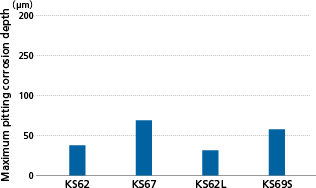Environment-Friendly, Free-Cutting Aluminum Alloys “KS Series”
For parts used in precision instruments, electrical equipment
and other items conform to RoHS or ELV directives
In the past, alloys with Pb-Bi additives (KS21, KS62) have been used as free-cutting aluminum alloys with excellent chip splitting performance. However, global environmental initiatives such as the EU RoHS directive*1 and the ELV directive*2 have prompted the need to develop more environment-friendly alloys. Accordingly, we have developed a lineup comprising five types of free-cutting alloys "KS Series" (KS21L, KS26, KS28S, KS62L & KS69S) that address environmental problems.
- *1 RoHS directive: EU regulations limiting the use of specified hazardous substances in electrical and electronic equipment.
- *2 ELV directive: EU regulations related to the recycling and disposal of end-of-life vehicles.
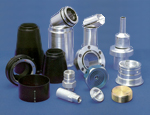
Features
- Depending on the application, alloys can be selected that are made up mainly of Al-Cu (KS2 series) or Al-Mg-Si (KS6 series) and that are either lead-free(lead content ≦ 0.05% by weight) or that fall lead threshold of RoHS and ELV directives(lead ≦ 0.4% by weight).
- The newly developed five types of alloys have essentially the same chip splitting performance during cutting and corrosion resistance as conventional KS21 and KS62 materials.
- Elevated temperatures must be avoided when working with Type 2000 free-cutting alloys, which contain elements with low melting points and is brittle at high temperatures above 120° C or higher. However, this high-temperature embrittlement can be avoided with KS26. Type 6000 free-cutting alloys do not exhibit the same sudden embrittlement as with Type 2000, but KS67 and KS69 show the trend to be somewhat brittle at temperature above 160 °C.
- Contact with alcohol-containing fluids has been confirmed to prompt dissolution of free-cutting alloys containing Sn . KS21L, KS26 and KS62L offer superior resistance to the dissolution.
Product Characteristics
Alloy characteristics
KS2 Series
〇:excellent, △:fair, ×:poor
| Alloy | Additive elements | Chip splitting performance*1 | Corrosion resistance*2 | Hot embrittlement resistance | Dissolution resistance*3 | ||
|---|---|---|---|---|---|---|---|
| KS21 | Conventional | Pb + Bi | 〇 | 〇 | △ | 〇 | |
| KS21L | Fall under RoHS and ELV directives | Pb < 0.4% | Pb + Bi | 〇 | 〇 | △ | 〇 |
| KS26 |
Pb free (Pb ≦ 0.05%) |
Bi | 〇–△ | 〇 | 〇 | 〇 | |
| KS28S |
Sn + Bi | 〇 | 〇 | △ | 〇–△ | ||
KS6 Series
| Alloy | Additive elements | Chip splitting performance*1 | Corrosion resistance*2 | Hot embrittlement resistance | Dissolution resistance*3 | ||
|---|---|---|---|---|---|---|---|
| KS62 | Conventional | Pb + Bi | 〇 | 〇 | 〇 | 〇 | |
| KS67 | Sn + Pb | 〇 | 〇 | △ | × | ||
| KS62L | Fall under RoHS and ELV directives | Pb < 0.4% | Pb + Bi | 〇 | 〇 | 〇 | 〇 |
| KS69S | Pb free (Pb ≦ 0.05%) | Sn + Bi | 〇–△ | 〇 | △ | △ | |
- *1 Chip splitting performance: Shapes of chips shapes differ, depending on cutting conditions
- *2 Corrosion resistance: Determined by maximum pitting corrosion depth after salt spray test for 200 hours.
- *3 Dissolution resistance: Determined by the amount of dissolution resulting from contact with brake fluid and other alcohol-containing liquids ( e.g., certain types of brake fluids).
Characteristics of KS2 Series alloy (Type 2000)
Alloy characteristics and mechanical properties (tempered T8)
| Alloy | Additive elements | Restriction for usage conditions (metal temperature) | Mechanical properties (Typical values) |
|||||
|---|---|---|---|---|---|---|---|---|
| TS[MPa] | YS[MPa] | El.[%] | Hv | |||||
| KS21 | Conventional | Pb + Bi | Not exceeding 120°C | 425 | 355 | 17 | 130 | |
| KS21L | Fall under RoHS and ELV directives | Pb < 0.4% | Pb + Bi | 425 | 325 | 28 | 125 | |
| KS26 |
Pb free (≦ 0.05%) | Bi | - | 430 | 340 | 25 | 125 | |
| KS28S |
Sn + Bi | Not exceeding 120°C | 420 | 330 | 23 | 128 | ||
Chip splitting performance (tempered T8)
| Conventional free-cutting alloy | Newly developed free-cutting alloys | General alloy | ||
|---|---|---|---|---|
| KS21 (Pb + Bi) | KS21L (Pb + Bi) | KS26 (Bi) | KS28S (Sn + Bi) | 2017-T4 |
 |
 |
 |
 |
 |
Hot embrittlement resistance
Charpy impact test values, compliant with JIS Z2242
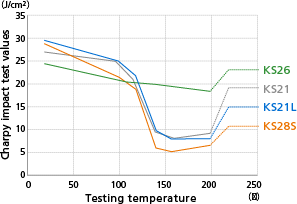
Corrosion resistance (tempered T8)
Maximum pitting corrosion depth after salt spray test for 200 hours, compliant with JISZ2371
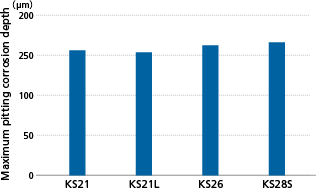
Characteristics of Type 6000 free-cutting alloy
Alloy characteristics and mechanical properties (tempered T8)
| Alloy | Additive elements | Restriction for usage conditions (contact liquids) | Mechanical properties (Typical values) |
|||||
|---|---|---|---|---|---|---|---|---|
| TS[MPa] | YS[MPa] | El.[%] | Hv | |||||
| KS62 | Conventional | Pb + Bi | - | 325 | 305 | 19 | 118 | |
| KS67 | Sn + Pb | Prevent contact with alcohol-containing liquids | 305 | 280 | 13 | 105 | ||
| KS62L | Fall under RoHS and ELV directives | Pb < 0.4% | Pb + Bi | - | 325 | 305 | 17 | 113 |
| KS69S | Pb free (≦ 0.05%) | Sn + Bi | Prevent contact with alcohol-containing liquids | 345 | 330 | 18 | 119 | |
Chip splitting performance (tempered T8)
Traverse cutting, rotating speed: 2,000 rpm, cutting depth: 1mm, feed rate: 0.04 mm/rev, lubricant: non
| Conventional free-cutting alloy | Newly developed free-cutting alloys | General alloy | ||
|---|---|---|---|---|
| KS62 (Pb + Bi) | KS67 (Pb + Sn) | KS62L (Pb + Bi) | KS69S (Sn + Bi) | 6061-T9 |
 |
 |
 |
 |
 |
Hot embrittlement resistance
Charpy impact test values, compliant with JIS Z2242
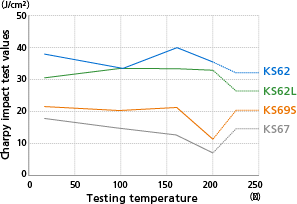
Corrosion resistance (tempered T8)
Maximum pitting corrosion depth after salt spray test for 200 hours, compliant with JISZ2371
